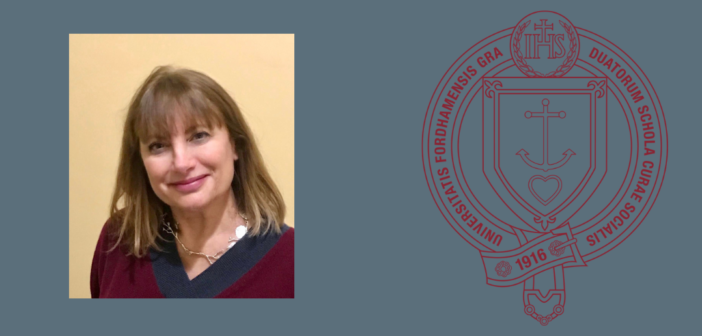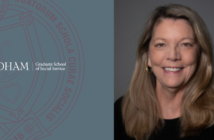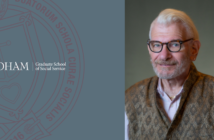As a Master of Social Work (M.S.W.) student at Columbia University, Phyllis Kosminsky envisioned a professional future in which she would provide supportive counseling and therapy to a range of help-seeking individuals. Her interest in clinical work excluded only one particular area: she did not wish to engage in work with bereaved people–people struggling after the loss of a loved one. Why? She’d already lived that struggle. At just nine years old, she lost her mother to cancer.
“Particularly in my internships and any work I was assigned, I stayed away from anything that had to do with death and dying,” Kosminsky said. “I specifically said, please do not put me in an environment where I’m talking to women who have cancer, or to children who have lost their mothers.”
Post-graduation, a chance encounter led Kosminsky to an interview at the Center for Hope, a community-supported agency offering individual and group counseling to people with life-threatening illness, their caregivers, and people grieving the loss of loved ones. As she sat in a waiting room lined with books on bereavement and grief, she experienced a change of heart.
“Often, the thing we avoid is where we’re most needed,” she said. “Sitting in that room I knew, despite everything I had felt for so many years, that this was where I belonged.”
Today, Kosminsky, a Fordham GSS adjunct faculty professor, released her latest book on grief and bereavement, Attachment Informed Grief Therapy: The Clinician’s Guide to Foundations and Applications, 2nd ed. (Routledge, 2024). Kosminsky and co-author John Jordan provide a wealth of research, theory, and clinical examples to support their contention that contemporary attachment theory and neuroscience research have the potential to deepen our understanding of grief and strengthen our work with bereaved individuals.
How We Form Relationships Impacts How We Grieve
Kosminsky said we are wired for connection from an early age. Furthermore, how we form these connections growing up can influence how we grieve later in life. Decades of research suggest that this “attachment style” develops in childhood and tends to persist into adulthood.
“While you may or may not be familiar with attachment theory, you already have experience with what its originators, John Bowlby and Mary Ainsworth, described as different ‘attachment orientations’ – secure, anxious, avoidant,” Kosminsky said. “What I mean by this is that based on your life experience, you’re aware that some people are inclined to want, and to pursue close relationships; others are less comfortable with and desirous of close relationships.
“And why is that? It really has a lot to do with what we learn from our earliest relationships.
Simply put, we learn from a very young age what kind of behaviors are most likely to result in our meeting our attachment needs. So some children cling to their caregiver to keep them close, while others learn that their caregiver does not respond well to clinginess. Both of these are examples of insecure attachment, one consequence of which is that the child does not feel comfortable moving between the protection of the caregiver and exploring their environment. A child whose parent provides them with a ‘secure base’ – (‘I trust that you’ll be there when I need you’) – is free to move between attachment, exploration, and play. Behavioral flexibility, a hallmark of secure attachment, is important in childhood, and it’s important in grief.”
This becomes clear when we look at models of the grieving process that have emerged in recent years. In contrast to the five-stage model of grief that persists in popular culture, grief researchers and clinicians identify normal grief as a process of oscillation, one in which the griever may feel fine one week (or even one day) and miserable the next.
“It was very important to me to share this way of understanding how we grieve with my clients. When a griever thinks they’re supposed to be going through five stages, they are upset by the erratic nature of their moods, and the rise and fall of their energy,” Kosminsky said. “I will often have a client come in and say, ‘I was fine last week. Why can’t I stop crying now?’ These individuals fear that they are regressing in their grief, a fear that adds to their distress about their loss.
“In normal, healthy grief, a person spends some time absorbed in their loss, feeling the feelings that are associated with the loss, and their restoration, which is, I’m going to think about what kinds of changes I need to make in my life in order to adapt to this new reality.”
Trouble arises, Kosminsky said, when the individual spends too much time immersed in loss or intent on restoration. If they’re overwhelmed by loss, it’s difficult to do anything but mourn. However, a single-minded focus on “getting back to normal” can be a sign of avoidance; throwing oneself into work or pleasure to avoid feelings of loss – this too can interfere with healing.
“The idea is that to heal from grief, we have to do both these things,” Kosminsky said. “We have to be able to feel our feelings, and we have to be able to move through them and create a life that is livable for us in the absence of the person who’s died.”
And who is more likely to “get their feet stuck in the quicksand” of either side of the oscillation process? The answer, Kosminsky explains, relates to our individual relationship orientations. The anxiously attached person is more likely to ruminate on their loss, and the avoidant-leaning person will compensate with too much restoration. Both are problematic. For the clinician, recognizing the individual’s relationship inclinations will set a framework for working with them toward healing.
What those clinicians should keep in mind, however, is although they are helping the healing process and we can grieve in a healthy way, grief cannot be “fixed.”
“Everybody who brings us a problem related to grief is bringing us a problem that we can’t solve,” she said. “And so the question becomes, what can I do?”
A Collaborative Publication for Anyone Confronting Grief
Attachment Informed Grief Therapy is a book for professional clinicians, but they aren’t the only ones who can use the content – which Kosminsky believes can be useful to anyone who has contact with grieving people.
“The book was written for those who work with people dealing with loss so they can do that more effectively,” she said. “It’s meant to help them have a way to answer the question, How can I help? What can I do?”
The book contains multiple case studies that connect theory to practice. All of the cases presented derive from the work of Kosminsky and her co-author, John Jordan, Ph.D., a licensed psychologist who for the past 45 years has specialized in helping those who have lost loved ones to suicide. Kosminsky said his contributions to the book were invaluable.
“He really took the lead in writing the sections on coping with suicide loss, and they’re really essential to the book,” she said. “Those sections are brilliant.”
The book is divided into intellectual domains (thanatology, neuroscience, and attachment theory), interventions based on the application of those domains to work with the bereaved, and the nature of relationships, trauma, and emotional regulation.
Connecting Her Work to Fordham’s Mission
Kosminsky, who has worked as an adjunct professor at Fordham GSS for four years, said the correlation between her research and the University’s person-centered mission is strong. Fordham’s Jesuit tenet cura personalis, or “care for the whole person,” resonates with Kosminsky and her work around grief. With her students, Kosminsky focuses on cultural variations in grief and the significant impact of the environment on well-being and the ability to live alongside grief.
“It’s very important that we have sensitivity to the context of people’s grief, including their culture, and the material reality of their day-to-day lives,” she said. “As social workers, this is a significant part of what informs and directs our practice.”
More than anything, Kosminsky’s newest work is a part of her ongoing effort to provide those who are suffering from loss-induced grief some respite from their hardship.
“From personal and professional experience, I know that to understand a person’s grief, we have to understand what it is that they have lost,” she said. “Along with Dr. Jordan, I hope this book will provide anyone in a position to offer grief support with a guide to best practice in helping people survive, and thrive, in the wake of loss.”



